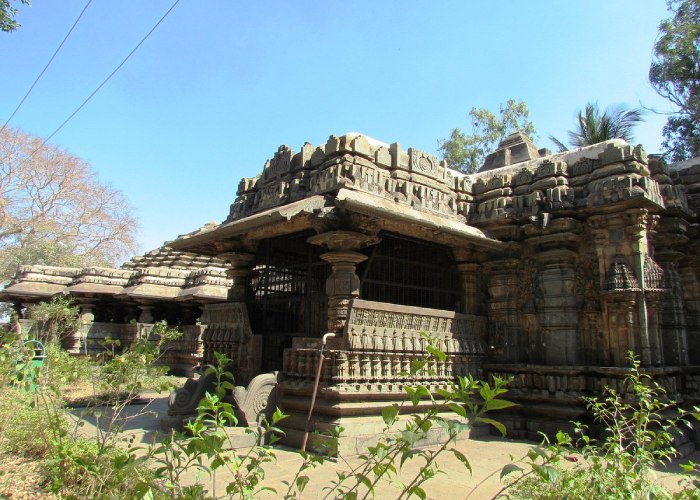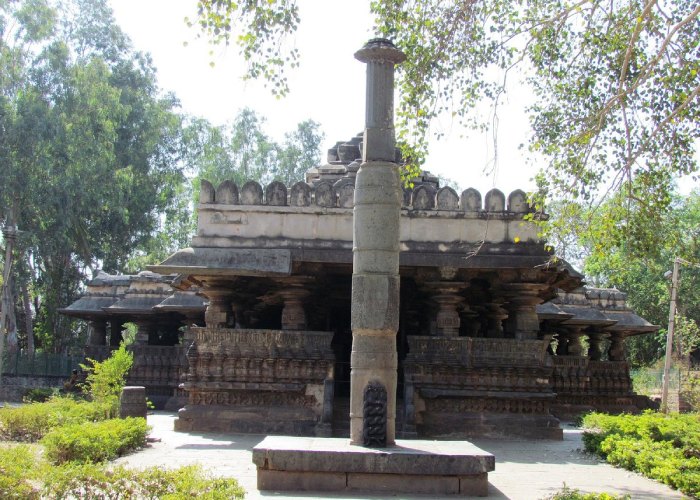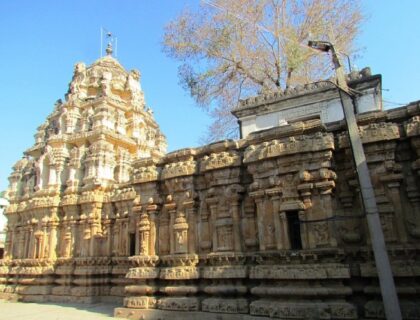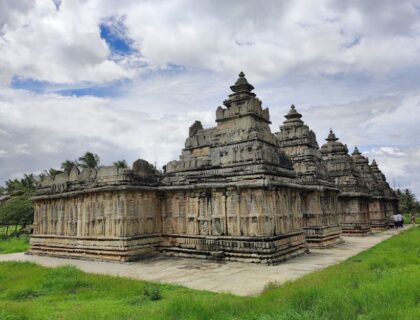Tarakeshwara Temple Hangal
The Tarakeshwara Temple is a Hindu temple complex dedicated to Lord Shiva as Tarakeswara which is located in Hangal, Karnataka, India. It also houses a temple dedicated to Shiva’s vahana, Nandi, and his son, Ganesha. The complex is a listed monument by the Archaeological Survey of India. It also has three memorial stones that depict religious and military scenes and are inscribed with Kannada text. Its octagonal hall features a 6-metre (20-foot) diameter lotus carving on the ceiling.
The temple’s name is derived from the Tarakeshwara form of Lord Shiva. Even though the credit for the construction of this temple goes to the Kadambas, it was the Kalyani Chalukyas who made significant changes to make it into the form we see today. It also has three memorial stones that depict religious and military scenes and are inscribed with Kannada text. Its octagonal hall features a 6-meter (20-foot) diameter lotus carving on the ceiling.
Legend of Tarakeshwara Temple
According to legend, the Pandavas agreed to spend their thirteenth year in concealment, known as “Ajnatavas,” as part of their agreement. If they were discovered during this time, they would face another twelve years of exile in the forest.

Hangal, also known as Virata in the Mahabharata, is thought to have been the location of the Pandavas’ thirteenth year of hiding. Hangal was referred to as Viratakote (Fort of Virata) and Viratanagara (City of Virata) in mediaeval documents.
History of Tarakeshwara Temple
To begin, the town of Hangal is thought to be Viratnagar from the epic Mahabharata. Viratnagar is where the Pandavas hid during their Ajnatavas (secluded living). The earliest known dynasty to rule Hangal was Kadamba. The Tarakeshwara temple was the Kadambas’ most significant contribution to the town’s history.

This temple became the base for the Shaivites, a group of devotees who worshipped Lord Shiva, during the twelfth century, when Jainism was gaining popularity. The town of Hangal is known as Viratnagar, which is related to the epic Mahabharata. It is believed that during their Agyatvas, Pandava princes sought refuge in Viratnagar disguised.
The Architecture of Tarakeshwara Temple
The temple was constructed in the Hoysala style using grey-green chloritic schist. More specifically, it is regarded as one of the best structures built in the Kalyana Chalukyan style, which was influenced by Hoysala architecture.

The “lotus of Hangal” is an octagonal structure that stands opposite the idol. The elaborately carved structure measures 9 metres (30 feet) in diameter. The structure’s ceiling is made of a massive stone with a diameter of 6 metres (20 feet). The stone, shaped like a lotus, is supported by eight pillars. Each of the eight pillars is flanked by sculpted stone pillars representing the Guardians of the Directions (ashtadikpalaka).

Near the main temple, there is a hall with 12 pillars that worships Nandi, Shiva’s bull. It and an adjacent hall are equipped with an inclined balcony for seating. The columns are carved with geometric designs and “lathe-turned” into an octagonal polished form. The two halls are topped with stepped pyramid roofs. The exterior walls are richly decorated with sculptures of miniature temples and other images.

The Ganesha temple is located northeast of the main temple and faces south. The temple has a “stepped plan,” with the sanctum preceded by a square-shaped open hall. The tower (shikhara) was built in the Nagara style and consists of several miniature towers in the North Indian style. The hall features a parapet with numerous carvings.
Important Facts About Tarakeshwara Temple
- Tarakeshwara, also known as Tarakeshvara Temple, is a Hindu temple complex in Hangal, Karnataka, 45 kilometres from Sirsi.
- It is an ancient temple in the Malnad region of Karnataka and one of the best places to visit near Sirsi.
- The Tarakeshwara Temple, dedicated to Lord Shiva, was built in the 12th century AD and is considered an architectural marvel.
- The temple represented the Kadambas’ most significant contribution to the town’s history. However, the town and temple rose to prominence during the reign of the Kalyani Chalukyas, who were the most powerful rulers in the Deccan during that time.
- They made significant architectural innovations and additions to transform it into its current form.
- The temple, built of grey-green chloritic schist, is an excellent example of the typical Chalukyan architectural style, with influences from Dravidian and Nagara styles.
- The main temple consists of a Garbhgriha or sanctum with surrounding enclosures such as the Antarala, Navaranga, Sabhamandapa, and Mukhamandapa.
- The sanctum sanctorum, which houses Lord Tarakeshwar, is designed in the shape of a linga and includes sculptures of Vishnu, Brahma, Karthikeya, and Nandi.
- The temple’s main hall is the focal point, with a large domeical ceiling in the shape of a lotus. The elaborately carved structure has a diameter of 9 metres and a ceiling made of a massive stone measuring 6 metres in diameter.
- The stone, shaped like a lotus, is supported by eight pillars. The pillars are decorated with very detailed elephant carvings and diamond-shaped motifs.
- Adjacent to the main hall is the Nandi Pavilion, which is dedicated to Lord Shiva’s vehicle, Nandi. This 12-pillared hall features a leaning balcony setting. Both halls have a stepped pyramidal outer roof.
- The exterior walls are richly decorated with sculptures of miniature temples and scenes from the Ramayana. The sculpture of a hero fighting a lion, the Hoysala kingdom’s emblem, is also on display.
- In front of the main hall, memorial stones depict religious and military scenes. The Ganesha temple located northeast of the Tarakeshwara temple has been built in the Nagara style and is worth a visit.
Best Time to Visit Tarakeshwara Temple
This place is heavenly and spiritual; you can visit it all year. The best time to visit this temple, however, is during the monsoon and winter seasons. During the monsoon season, this location receives moderate to heavy rainfall, making it appear heavenly with its greenery and bringing freshness elsewhere.
How to Reach Tarakeshwara Temple
By Air: The nearest airport is located in Hubli. If you prefer to travel by air, you may need to fly to Hubli and then take a bus or private cab to Hangal.
By Rail: The nearest railway station to the temple is the Haveri railway station which is approximately 40 km from the temple.
By Road: Hangal has a well-developed bus network that connects it to other districts in Karnataka. The state bus depot in Hangal is very close to the Tarakeshwara temple. One can also take a cab from one of Karnataka’s major cities, such as Bangalore or Mysuru.
Also Read – Chennakeshava Temple Belur
Location
Facilities
- Drinking Water
- Pooja Item Shops
- Prasad Shops
- Restaurants Nearby
- Resting Room







































Reviewed on January 11, 2025For those planning to visit, it might also be useful to check out some price comparisons at https://world-prices.com/en/india/prices, though it’s hard to say how accurate the data is. Keep up the great work!